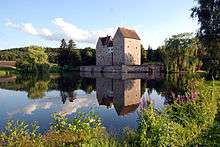Brennhausen

Coordinates: 50°14′50.7″N 10°31′19″E / 50.247417°N 10.52194°E Brennhausen (German: Burg Brennhausen) is a castle in the municipality of Sulzdorf a.d.Lederhecke in the district of Rhön-Grabfeld in Bavaria in Germany. It is located the Haßberge Nature Park.
Origin of name
Houses of Springs
Josef Braun explains the name Brennhausen in his place-names book as "the houses by a water source", meaning, in this case, a spring. Braun bases his statement on the fact that immediately next to the settlement, a stream springs forth which flows into the river Saale. Braun discovered that the form Brenn- is a written form, changed from the spoken dialect, which is based on the old form Brünn.
Houses of Brunicho
Dr. Heinrich Wagner presents a very different view in his Historischen Atlas von Neustadt/Saale (Historical Atlas of Neustadt/Saale). Wagner believes that the origination of the name had nothing to do with the houses by a water source, but rather that the name of the estate is derived from the old German given name, Brunicho. Under this scenario, the founder of Brennhausen used his own name, as was the custom of that time, for the naming of Brunechenhusen.
Officially documented
The first known mention of Brennhausen in an official document was in the year 1182. In this document, Graf Poppo von Henneberg, (VI?) leased to his faithful Wolfram, among others, a tenth of Brunechenhusen. On August 29, 1237, Graf Poppo von Henneberg, VII declared that his vassals "Deynodapifer and Theodericus, so-called von Blanckenberg," must repair the damage done to the Brunechenhusen property when it was unjustly withheld from the abbot and the Bildhausen convent.
Truchseß von Brennhausen
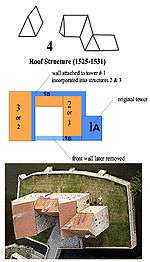
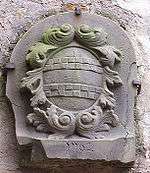
The Truchseß von Brennhausen is a genealogical branch of the Truchessen von Wetzhausen which descends from a Hans Truchseß (1260–1330). He had holdings in Wetzhausen, Brennhausen, Sternberg and Essfeld. In the official property record book of the Bishop of Würzburg, Gottfried III von Hohenlohe, with records from 1317 to 1322, it was written that one Truchseß von Blankenberg, and possibly the so-called Hans Truchseß, had holdings in Brennhausen.
In another record book of the Prince-Bishop Albrecht von Hohenlohe, used from 1345–1372, it was written in 1345: “Johannes Truchseß von Alsleben owns also a tenth of Gabolshausen, a tenth of Poppenhausen, a half-tenth of Ermershausen, a tenth of Brennhausen, and a half-tenth of Maroldsweisach.”
In 1343, Hans Truchseß was mentioned in a directory of Wetzhausen. It was written: “Notation regarding Mr. Hansen Truchseß, soul of a knight of Brünnhausen and his wedded wife. Owned Wetzhausen, Brünnhausen, Eßfeld and part of zu Sternberg.” His four Sons inherited these four places after his death and started four independent lines which later branched out even more. Diez, the actual founder of the Wetzhausen line, was given by his father, Hans, all of Wetzhausen and one third of Brennhausen. Hans Truchseß the Younger (1309–1370) received two thirds of the Brennhausen holdings and part of Sternberg. Hanns had his residence in Brennhausen.
Brennhausen remained in the Truchseß family until 1542 when Georg Truchseß died with a brief intermission around 1500. Anna, daughter of Philipp Truchseß took Brennhausen into a marriage with Hans von Berlichingen, a vassal of Wilhelm Count von Henneberg. After Hans von Berlichingen death, Anna sold Brennhausen to pay her husband’s debts and Brennhausen ended up with Dietz Truchseß.
Bauernkrieg and the Burning of Brennhausen
Both documentation and physical evidence strongly suggest that Brennhausen burned in 1525 during the Bauernkrieg or Peasants (or Farmers) Revolt. The beams of the roof and the entrance to one of the cellars date from right after 1525. Stone work also suggests that the floor levels changed at some point. Also G.P. Höhn in his 1747 Lexicon Topographicum states that the peasants set fire to it in 1525.
1542-1681
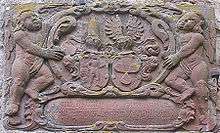
In 1587 Brennhausen was occupied by Georg Wilhelm von Kotzau. By 1593, the Truchseß family were back at Brennhausen. In 1619, the brothers Otto, Heinrich and Adam von und zu Bastheim along with Georg Wilhelm and Veit Ulrich Truchseß von Wetzhausen purchased Brennhausen for 24,597 gulden.
Günther von Brennhausen
In 1642, a Franz Günther, a simple farmer's son from Kützberg by Schweinfurt, was ennobled “Günther von Brennhausen” and given the fief of Brennhausen from the Bishopric of Würzburg. From 1635 to 1647, Franz was the Commandant of the fortress at Königshofen. Franz’ son Hans, also a distinguished military man, received Brennhausen. Hans and his second wife Felicitas Agnes Leschin von Mülheim coat of arms are in the courtyard. The transfer to their minor son, Johann Georg Hartmann Günther von Brennhausen, upon Hans' death was held up in court in part due to Felicitas Agnes being protestant. The case was eventually won in 1679 and invested in 1680, only to pass away in 1681.
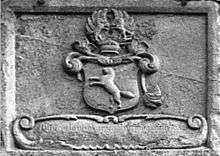
Brennhausen goes to Bibra family
In 1681, the von Bibra family received Brennhausen instead of Burgwallbach as part of an out of court settlement of a lawsuit dating from 1602 when the Prince Bishop Julius Echter von Mespelbrunn refused to transfer family fiefs between cousins. This type of transfer was routine but during the Counter Reformation, the bishop refused a transfer to the Protestant cousins. Initially a fief to the Bibra family, it was converted to personal ownership and in 2002 transferred to the Stiftung Brennhausen (Foundation).
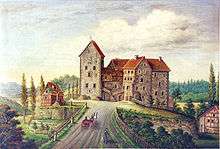
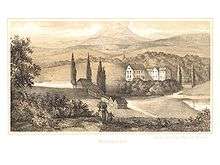
Traditions
There is a tradition which states that Brennhausen, in older times, was a monastery, which is where the naming of the surrounding fields, Nonnenäcker (nun’s fields) and Pfaffenpfad (pastor’s path) must have come.
Brennhausen the Village
In past centuries there were more houses at Brennhausen. Anton Rottmayer in Statistisch-topographisches handbuch für den Unter-Mainkreis des königreichs Bayern published in 1830 describes Brennhausen as having: one castle, seven residences, one mill with two mill stones, ten families, 56 residents, 22 Catholics, 34 Protestants with the Protestants going to Sulzdorf for church and school and the Catholics going to Obereßfeld. In 1832, Johann Wilhelm Rost, described fifty-one inhabitants in twelve families lived at Brennhausen. Ten of them were Catholic, thirty-six Lutheran, and five Jewish. The Catholics went to church in Untereßfeld and the Lutherans in Sulzdorf. Until 1848, Brennhausen had original jurisdiction over its own affairs. In 1915 (WWI), Brennhausen had six residences besides the castle but only two were inhabited. The other four were dilapidated.
Photo gallery
References
- REINHOLD ALBERT: Chronik der Gemeinde Sulzdorf an der Lederhecke. (2 Volumes, zus. 860 S.) hrsg. von der Gemeinde Sulzdorf a. d. L., Verlag Frankenschwelle (Hildburghausen) Pages. 515 - 534. 1994. This is the most thorough source on Brennhausen and the main source on the history of Brennhausen for initial article.
- REINHOLD ALBERT: Beiträge zur Geschichte der Gemeinde Sulzdorf a.d.L. (Folge 115) Um Brennhausen wurde vor dem Reichskammergericht gestritten, (Günther von Brennhausen lawsuit) Pages 41–48, Echo der Lederhecke, Nr. 1/2014
- HANS KARLINGER, Die Kunstdenkmäler Des Königreichs Bayern, Unter-Franken, XIII. Bez.-Amt Königshofen, 1915, pp. 26–29.
- JOSEF BRAUN, Historisches Ortsnamenbuch von Bayern, Volume: Koenigshofen im Grabfeld, page 3.
- Hennebergisches Urkundenbuch, Teil V., Page 243, Number 405
- HANS KARLINGER, Die Kunstdenkmäler von Bayern, III, 13. Bezirksamt Königshofen. - Munich, 1915 (Reprint Munich, 1983, ISBN 3-486-50467-3)
- BRIGITTE LOHER, Contributions to the History and Genealogy of the Truchsess’s of Wetzhausen in the Middle Ages, p. 46
- FRITZ MAHNKE, Schloesser un Burgen im Umkreis der Fraenkischen Krone, page 50.
- HEINRICH MEHL,Burgen und Schloesser in Rhoen und Grabfeld, pages 60–63.
- FRANZ SAYN-WITTGENSTEIN, Schlosser in Franken : Residenzen Und Landsitze Im Frankischen, 1974 ISBN 3-406-03575-2 ISBN 978-3-406-03575-3;
- HEINRICH WAGNER, Historischer Atlas von Neustadt/Saale, page 21A.
External links
| Wikimedia Commons has media related to Brennhausen. |




